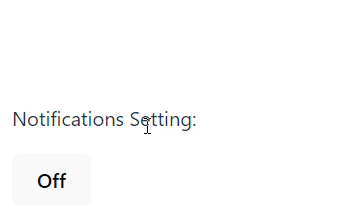RxJS 是一个功能强大的库,但众所周知,它的学习曲线很陡峭。
该库庞大的 API 界面,再加上向反应式编程的范式转变,可能会让新手不知所措。
我创建了 Reactables API 来简化 RxJS 的使用并简化开发人员对反应式编程的介绍。
我们将构建一个简单的控件来切换用户的通知设置。
它还会将更新的切换设置发送到模拟后端,然后向用户显示一条成功消息。

npm i rxjs @reactables/core
import { RxBuilder, Reactable } from '@reactables/core';
export type ToggleState = {
notificationsOn: boolean;
};
export type ToggleActions = {
toggle: (payload: boolean) => void;
};
export const RxNotificationsToggle = (
initialState = {
notificationsOn: false,
} as ToggleState
): Reactable<ToggleState, ToggleActions> =>
RxBuilder({
initialState,
reducers: {
toggle: (state) => ({
notificationsOn: !state.notificationsOn,
}),
},
});
const [state$, actions] = RxToggleNotifications();
state$.subscribe((state) => {
console.log(state.notificationsOn);
});
actions.toggle();
/*
OUTPUT
false
true
*/
RxBuilder 创建一个 Reactable,它是一个包含两个项目的元组。
UI 可以订阅状态更改的 RxJS Observable。
UI 可以调用以调用状态更改的操作方法的对象。
使用 Reactable 时不需要主题。
我们可以用纯reducer函数来描述我们想要的行为。
Reactables 在幕后使用主题和各种运算符来为开发人员管理状态。
Reactables 处理异步操作,其效果表示为 RxJS 运算符函数。它们可以用触发效果的操作/减速器来声明。
这使我们能够充分利用 RxJS 来处理异步逻辑。
让我们修改上面的切换示例以合并一些异步行为。为了保持简短,我们将放弃错误处理。
import { RxBuilder, Reactable } from '@reactables/core';
import { of, concat } from 'rxjs';
import { debounceTime, switchMap, mergeMap, delay } from 'rxjs/operators';
export type ToggleState = {
notificationsOn: boolean;
showSuccessMessage: boolean;
};
export type ToggleActions = {
toggle: (payload: boolean) => void;
};
export const RxNotificationsToggle = (
initialState = {
notificationsOn: false,
showSuccessMessage: false,
}
): Reactable<ToggleState, ToggleActions> =>
RxBuilder({
initialState,
reducers: {
toggle: {
reducer: (_, action) => ({
notificationsOn: action.payload as boolean,
showSuccessMessage: false,
}),
effects: [
(toggleActions$) =>
toggleActions$.pipe(
debounceTime(500),
// switchMap to unsubscribe from previous API calls if a new toggle occurs
switchMap(({ payload: notificationsOn }) =>
of(notificationsOn)
.pipe(delay(500)) // Mock API call
.pipe(
mergeMap(() =>
concat(
// Flashing the success message for 2 seconds
of({ type: 'updateSuccess' }),
of({ type: 'hideSuccessMessage' }).pipe(delay(2000))
)
)
)
)
),
],
},
updateSuccess: (state) => ({
...state,
showSuccessMessage: true,
}),
hideSuccessMessage: (state) => ({
...state,
showSuccessMessage: false,
}),
},
});
在 StackBlitz 上查看完整示例:
反应 |有角度
让我们将 Reactable 绑定到视图。下面是使用 @reactables/react 包中的 useReactable 钩子绑定到 React 组件的示例。
import { RxNotificationsToggle } from './RxNotificationsToggle';
import { useReactable } from '@reactables/react';
function App() {
const [state, actions] = useReactable(RxNotificationsToggle);
if (!state) return;
const { notificationsOn, showSuccessMessage } = state;
const { toggle } = actions;
return (
<div className="notification-settings">
{showSuccessMessage && (
<div className="success-message">
Success! Notifications are {notificationsOn ? 'on' : 'off'}.
</div>
)}
<p>Notifications Setting:</p>
<button onClick={() => toggle(!notificationsOn)}>
{notificationsOn ? 'On' : 'Off'}
</button>
</div>
);
}
export default App;
就是这样!
Reactables 允许我们使用纯减速器函数构建功能,而不是深入主题世界,从而帮助简化 RxJS。
然后,RxJS 被保留用于它最擅长的地方 - 组成我们的异步逻辑。
Reactables 可以扩展并做更多事情!查看文档了解更多示例,包括如何使用它们管理表单!
以上是使用 Reactables 简化 RxJS的详细内容。更多信息请关注PHP中文网其他相关文章!




